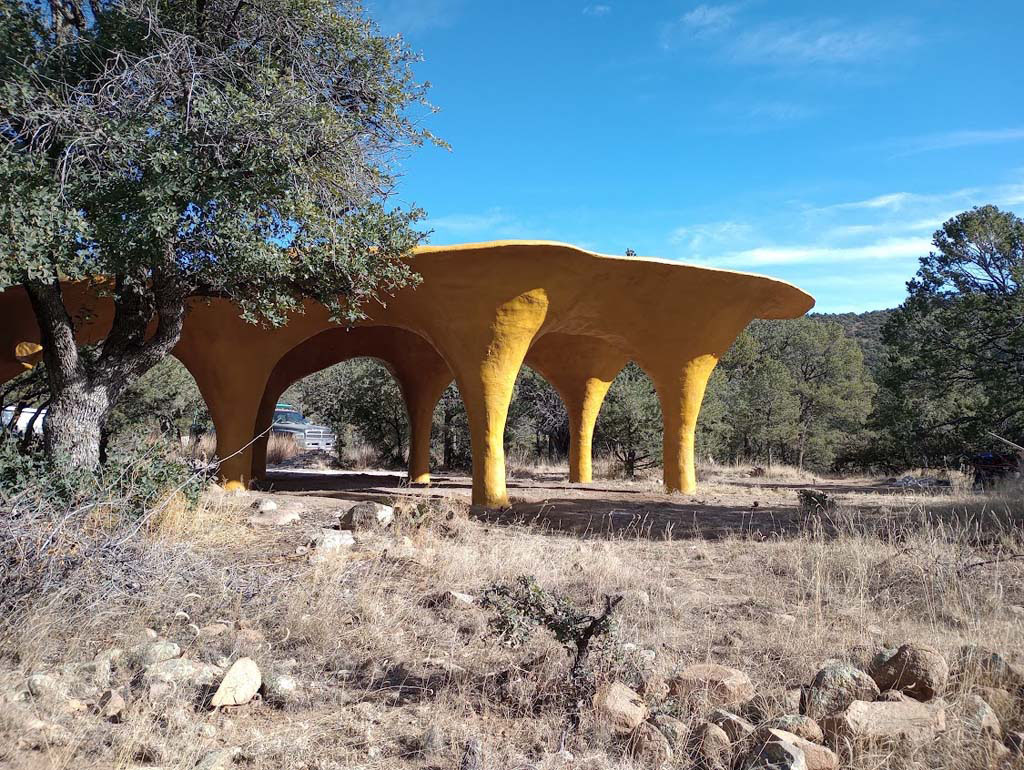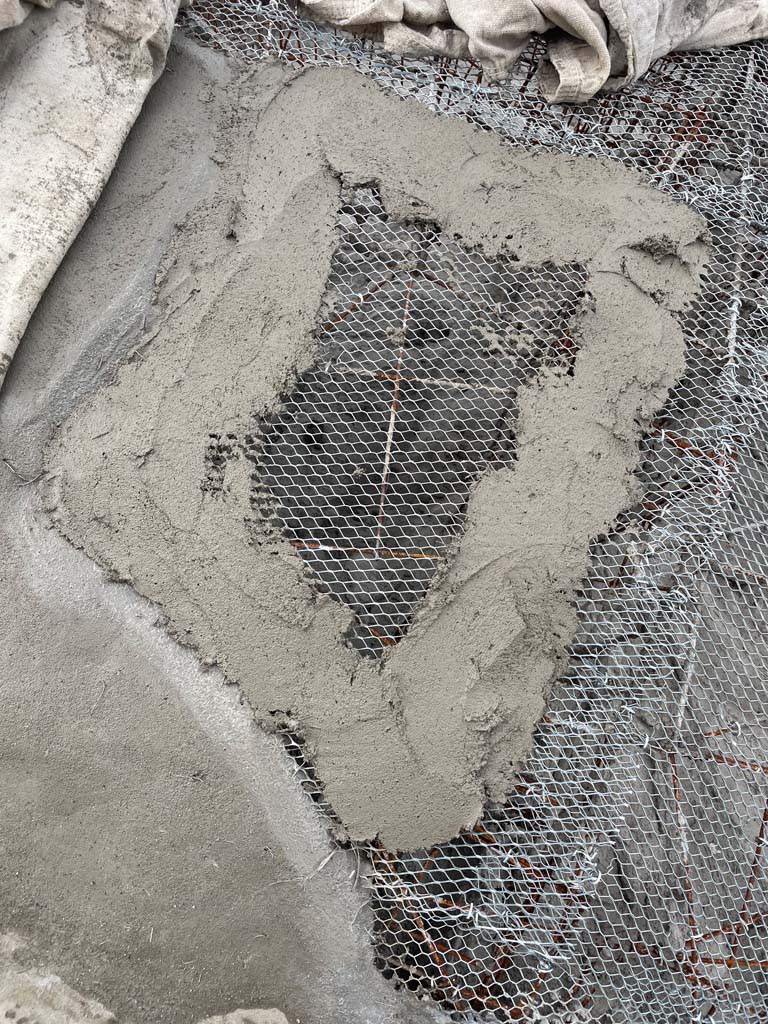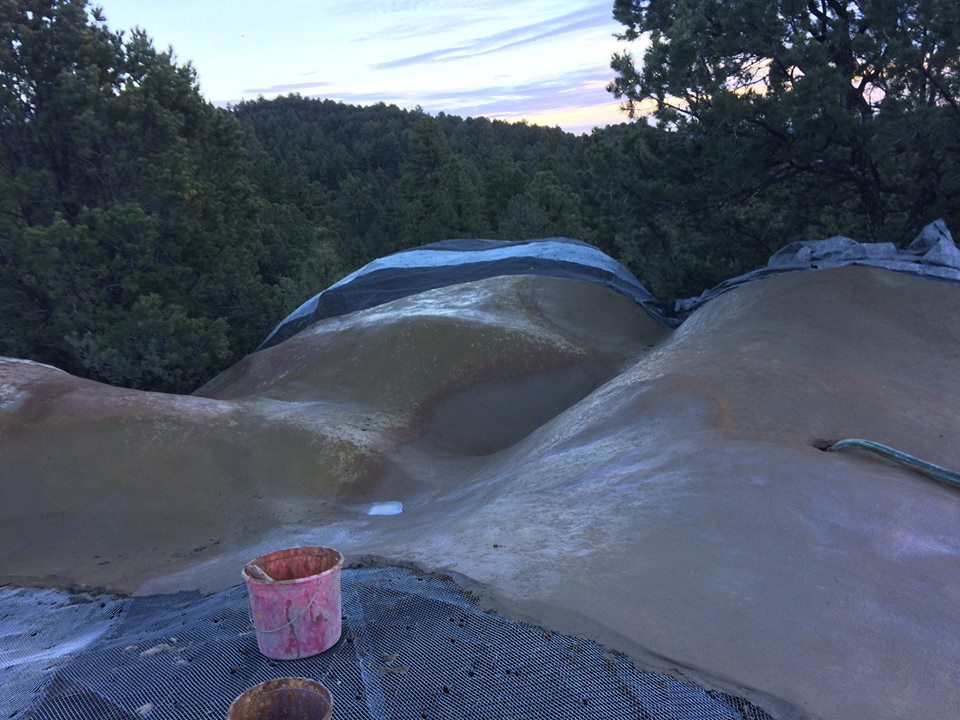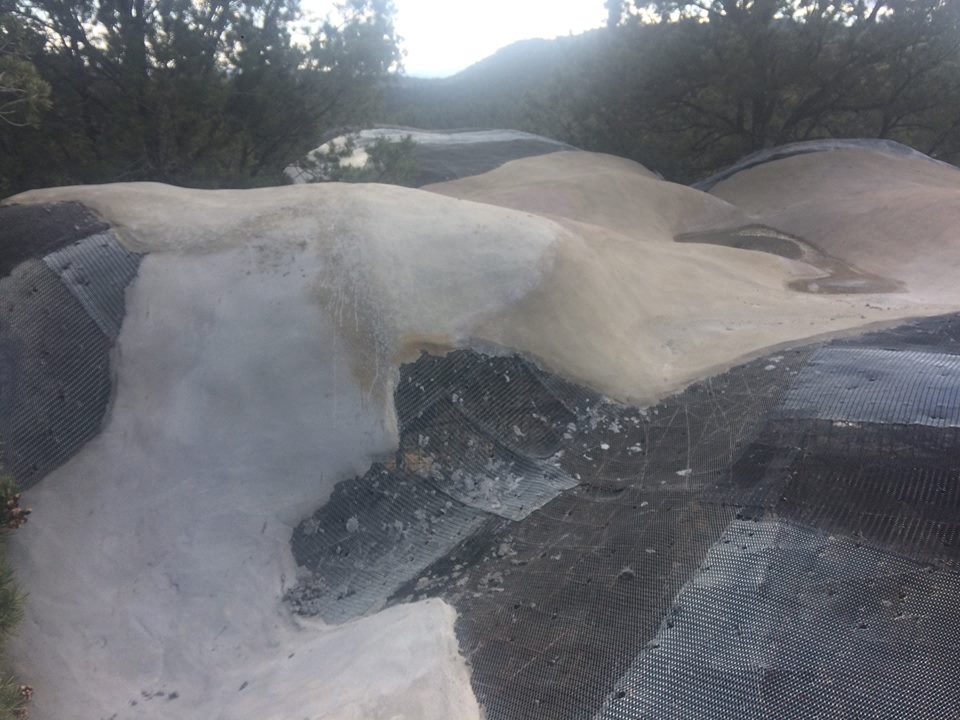





FlexCore SuperShell is a field-friendly, hand-applied composite designed for thin shell construction that outperforms traditional concrete in every category that matters: bond strength, durability, workability, and environmental resilience. Built using reactive powder mortar technology, it integrates deeply with metal reinforcement, resists damage from fire, frost, and corrosion, and offers longevity far beyond the standard service life of conventional cement-based systems.
This material was created not just for strength — but for reliability, ecological harmony, and long-term durability in the wild. When applied over wire-grid and expanded metal lath, it forms a seamless, load-bearing skin that becomes the heart of the Core Monolith Pavilion and other Flex-Shell structures.
Extremely durable — resists corrosion, frost, chemical attack, and physical impact
Outperforms conventional mortars by a wide margin in both strength and toughness
Ultra-low water-to-cement ratio: 0.155 – 0.177 = minimal shrinkage, tight bond
Non-Newtonian rheology promotes deep bonding to steel — dramatically reduces risk of spalling or delaminating.
Closed-cell aeration prevents moisture intrusion and absorbs expansion pressure
Zero capillaries — waterproof and vapor-proof
Crack-resistant and self-maintaining — thanks to dense internal structure and high silica content, cracks self-heal.
Expected service life measured in centuries or millennia, not decades
Built for the field — forgiving of slight mixing variations and intuitive to apply
FlexCore SuperShell makes it possible to replace reinforced co
ncrete (RC) in many applications using:
Structural sandwich geometry
Thin-shell curvature for strength and flex-s
tability
Precision-formable trusses made in situ
Using 90% less Portland cement than traditional RC — and with significantly less material volume — it reduces embodied energy while improving performance. Labor and cost are minimized while structural adaptability and resilience increase.
Rather than rely on abstract psi figures, FlexCore SuperShell’s field performance is defined by two simple, testable factors:
Wet mix density directly correlates to compressive strength
Test cubes made onsite verify performance and track quality
Unlike brittle conventional mortars, broken cubes retain 60–80% of their peak strength, showing progressive yield rather than catastrophic failure. This makes FlexCore not just strong — but inherently reparable.
Silica fume (Eucon MSA) and STAR 3-Micron fly ash react with cement by-product lime (Ca(OH)₂), forming Calcium Silicate Hydrate (C-S-H) — the dense binder responsible for long-term strength and internal cohesion.
The dense matrix eliminates capillaries, leaving no pathways for moisture or chemical attack.
Alkali-Silica Reaction (ASR) — a major durability threat in conventional concrete — is eliminated through complete particle hydration and chemical stabilization.
Mearlcel 3532 foam introduces sealed micro-bubbles that:
Absorb impact like tiny airbags
Provide expansion space for ice, rust, and sulfide reactions
Eliminate moisture movement
Prevent spalling and delamination
These bubbles do not weaken the shell significantly due to the high strength of the surrounding matrix.
The mix has a slightly self-leveling, non-Newtonian behavior:
It flows slightly at rest, creeping into and around the edges of wire fabric and grid reinforcement.
This unique characteristic causes the mortar to grip the steel, creating a mechanical bond so strong that portions of the shell cannot separate or spall under load or damage.
Expanded metal lath is fully embedded. The mortar fills each eyelet, converting compressive load into distributed tensile resistance, enhancing flexural strength and distributing deformation energy across a wider area.
| Ingredient | Quantity | Function |
|---|---|---|
| ASTM C144 Plaster Sand (sifted) | 5–5.25 gal | Base aggregate |
| Fine Silica Sand (20–80) | 3 quarts | Filler, micro-packing |
| STAR 3-Micron Refined Fly Ash | 1.8 quarts | Pozzolanic filler, densifier |
| Eucon MSA (Silica Fume) | 1.5 quarts | Nano-scale pozzolan |
| Plastol 5000 | 10.5 oz | Superplasticizer, water reducer |
| Water (initial) | 1.2 quarts | Begin hydration |
| Portland Cement (Type I/II) | ¼ bag (≈23.5 lb) | Main binder |
| Water (final tuning) | Up to 0.8 quarts | Rheology adjustment |
| Mearlcel 3532 Foam | 0.6 gallons | Closed-cell aeration |
| Forta Ferro Fibers | 0.7 quarts | Crack and impact resistance |
| Nycon PVA-RSEC 15 Fibers | 0.5 quarts | High-bond fiber reinforcement |
🔧 Mixing Instructions:
Combine all ingredients except Portland cement, and mix for 9 minutes to activate pozzolanic materials.
Add Portland cement, then mix another 9 minutes.
Add final water in 3–4 oz doses every 2–3 minutes, adjusting for temperature and humidity.
Target a soft, cohesive rheology — no slumping, no self-leveling.
Scrape blades several times to ensure total mixing.
Tight bonding to reinforcement minimizes structural separation
Freeze-thaw safe — ice expands inside bubbles, not between particles
Rust-tolerant — expansion from corrosion is absorbed before it can break the matrix
Water-safe — no leaching, stable pH, ideal for cisterns and planters
Fire-resistant — high thermal tolerance, zero combustion risk
Long lifespan — no progressive chemical degradation, minimal environmental fatigue
Use FlexCore SuperShell for:
Structural domes, vaults, and pavilions
Fire-shielded homes and wildfire buffer zones
Earth-stabilizing retaining walls in sloped terrain
Passive water reservoirs and wicking garden beds
Sustainable cisterns, ponds, and irrigation channels
Architecture that integrates soil, water, structure, and life
FlexCore SuperShell isn’t just a high-performance building material — it’s a philosophy of structure aligned with nature. Its strength comes not only from technical chemistry, but from its ability to integrate with steel, stone, soil, and terrain. Designed to reduce labor, conserve resources, and endure extreme conditions, this system gives back stability and self-sufficiency where conventional methods extract.
“This isn’t just about concrete — it’s about building something that endures. FlexCore SuperShell is the foundation of architecture that serves life, not just structure.”
The compressive strength is also more predictable because there is assurance that all the cement particles are fully hydrated where as, in traditional concrete, an uncertain amount of dry Portland cement remains nonreactive, depending upon factors such as a water content, composite characteristics, and mixing speed and method. These variations in moisture content and cement hydration that cause fluctuating results are eliminated with this mix design.
Eucon MSA (Silica Fume)
Eucon MSA is 0.3 micron nano-sized silica particle that contributes to the reactive powder or pozzolanic effect by reacting with the lime (Ca03) by-product of the Portland Cement reaction in the highly densified ultra low-water environment.
Plastol 5000
This is a high-range super plastisizer/water reducer from Euclid Chemical Company, the same ones that supply the Eucon MSA silica fume. It is based upon the original formula, Boral SPJ, that was created by Boral Materials Technology and responsible for Boral’s 16,500 psi pea gravel mix. This was before Euclid bought Boral’s chemical division. It blends the high tech polycarboxylate binders with the old-school Mg and Ca lignosulphonates polymers, originally derived from the Japanese Cypress trees, the ‘J’ part of the SP “Super Plastisizer”. This blend stabilizes working time and helps prevent segregation in high doses while contributing powerful polymer binders. The dosage for the 1/4 batch, 1/4 bag of Portland cement, is 10.5 fluid oz, and that is added to the 5 to 5.25 gallons of ASTM C144 plaster sand, that is usually sifted on a tilted 3/16 inch stainless steel screen to minimize the ratio of coarser particles and includes 3 quarts of fine silica sand such as 20-80 Sand Blasting Sand. That mix also includes 1.8 quarts of STAR 3 Micron Refined Silica Fume and 1.5 quarts of Eucon MSA and 1.2 quarts water and blended for 9 minutes BEFORE adding the Portland cement. This is mixed in high shear forced-action pan mixer or a standard horizontal paddle mortar/plaster mixer that requires scraping the paddles to ensure no clumping. Add the Portland cement and let mix another 9 minutes adding 3 – 4 oz doses of water, spaced 2 minutes apart or until the desired rheology is achieved. That rheology is a low friction softness with minimal self-leveling settling movement. Try to avoid a self leveling rheology at all stages of mixing and stop the mixer for about 20 seconds, 2 to 3 times, to scrape the blades to ensure thorough mixing when using a standard plaster mixer. A concrete mixer is not likely to provide but the sheer mixing needed but my first house, a fully monolithic house based in a previous system, I was able to by using a concrete mixer and a drill mixer paddle at the same time, which looks really dangerous, but it worked on those first trials. The total water should not exceed 2 quarts, usually about 1.8 quarts, but there is variability there due to temperature, humidity and wind. This sequence ensures minimum hydration, maximum strength, maximum reactive powder effect, soft spreadability as a plaster that sticks well overhead and maximum working time. It is key to monitor the rheology, the softness and movement after the blades are stopped. The full batches seem to require about half the Plastol 5000. The maximum amount of water reducing combined with the proper ratio micro silica sizes mostly eliminates permeability and brings the particles close together so they can react to increase strength instead of leach out. The material does not leach out lime as much as regular mortar and so does not change the PH when used for aquariums, ponds, water tanks and water features. of the composite is improved, and the shell does not shrink when it dries.
STAR 3 Micron (Refined Fly Ash Pozzolan)
STAR 3-Micron is a refined micro pozzolan derived from recycled Fly Ash that is about 10 times larger than the silica fume, so helps efficiently fill the micro voids around the much larger cement and aggregate particles when used in the precisely correct quantity and ratio while contributing significantly to the CaO3 pozzolanic effect and the Calcium Carbonate late strength gain pozzolanic effect. This results in a denser, higher strength matrix with fewer voids and better chemical bonding between the aggregate particles. The STAR 3 Micron is used at only 12 to 15 percent of cement, which is a sharp contrast to regular flyash doses. This lower dose made possible by a refined flyash greatly decreases the water demand and maximizes the reactive powder pozzolanic effect.
Mearlcell 3532
Capillary causing gel water is fully eliminated by the final adding of a special synthetic foamed additive called Mearlcell 3532. The additive is foam that is produced from the concentrated foaming compound in a foam generator or foaming drill paddle. It makes a foamed material that resembles shaving cream and provides the property known as Closed Spherical Cell Aeration that is distinct from open capillary aeration or air entrapment in important ways. It is typically used for making cellular concrete, or foamed concrete, which is a low-strength cementitious composite. Foamed concrete should not be confused with experimental methods sometimes referred to as ‘aircrete’ that use soap to make a light aerated alternative to the engineered methods and formulas. Mearlcell 3532 contributes to the durability and workability by adding 0.6 gallons to the 1/4 batch mix that is a little less than 6 gallons total volume. The foam weakens the mortar slightly, but that is an affordable compromise considering the mortar is still at least double the strength of regular mortar. It is important creates closed spherical cells in the matrix that prevents water intrusion, provides impact protection and protection from chemical expansion damage, such as rust, salts and ice. This increases the longevity of the high-strength shell. It also improves the softness and workability of the mortar plaster a small degree. It also seems to bind with extra water that may be in the mix and converts that water to foam, which helps make the material somewhat forgiving if slight mistakes in water portions are made, which is easy to do if you are not providing the right amount of initial water 0.8 to 1.25 quarts, for the standard 1/4 batch mix, most of the mixing water, in the beginning and then waiting the 9 minutes while all the silica’s mix with the water reducer, then waiting 3 to 4 minutes in between the small 3 – 4 ounce doses of water while carefully watching the mix to ensure the nearly self-leveling rheology is maintained while those micro silicas slowly react with the lime produced by the cement hydration. I strongly recommend you get familiar with the 6 gallon 1/4 batch, 1/4 bag of Portland batch, before you move to larger batches to ensure you have a feel for how to achieve minimum hydration by maintaining the perfect rheology after the Portland cement reacts and makes a fluid mortar.
It takes a little time, between 22 and 35 minutes of high-sheer mixing, while periodically scraping the blades and watching the mix, checking on it at certain intervals to dial in mix for your specific humidity and temperature conditions and so master a true minimum hydration, maximum reactive powder effect, maximum pozzolanic effect, maximum strength and perfect workability in a hand-applied plaster.



Impact Resistance
The closed cell aeration also provides impact resistance. When you have a very hard shell, it can be brittle and susceptible to long impact cracks. The air bubbles in this shell actually absorb impact and prevent cracking. The tiny air bubbles act like air bag cushions and by absorbing kinetic energy in the same way. A hammer blow or bullet will make a tiny smooth dent instead of breaking and cracking.
Freeze/Thaw or Ice Protection
The closed cell aeration also provides a place for chemical expansion of freezing ice. The ice crystals form inside the bubbles like little stalactites in a cave instead of wedging apart aggregate by getting in the voids between.
Rust & Chemical Expansion Protection
Ice isn’t the only thing that expands and breaks concrete. Iron oxide is five times the volume of iron. This is why our steel reinforced concrete infrastructure is failing and only has a service life of a few decades. The closed spherical cell aeration prevents progressive cracking and moisture intrusion. This aeration also causes the rust to grow inside the spherical cell voids instead of causing internal stress and breaking within. The rust growth within the cells also creates a chemically stable zone around the steel in or near the matrix. This has a fossilizing effect on the steel and stops the rust after a certain amount has created a stabilized barrier zone. This effect may help structures made with these shells to last thousands of years instead of hundreds since the both the known mechanism that damage concrete, freeze/thaw damage and chemical expansion, are removed.
Impervious Water-Proof & Vapor-Proof Barrier
The tighter matrix also means there are less voids or capillaries surrounding the aggregate particles. This absence of porosity gives the shell a higher surface-scratch hardness. This is because the aggregate particles are bonded more tightly. This enables the shell to block moisture or vapor from penetrating.
Absence of Shrinkage Stress and Cracks
The high-strength mortar uses much less water and it is often called ultra low-water mortar. As a result of using the smallest amount of water possible, the mix shrinks less as it cures. Less shrinkage helps the composite bond more tightly to the supporting reinforcing by pulling away less from the contact edges and surface. Less shrinkage also helps prevent shrinkage cracks and internal strains inside the shell. More important, the absence of shrinkage in a low-water smooth liquid style mortar, as opposed to a dry-packed grout, indicates the mortar is without open capillaries. These open capillaries, that define the difference between vapor-proof shells and standard concrete mortar shells, are created as the excess mix water and gel water in the wet matrix dries off. Without the open capillaries, these high-strength mortar shells exhibit radically different properties than standard cement based mortar. They are fundamentally different in terms of structural performance and durability by demonstrating greater resistance to chemical attack, freeze/thaw damage, impact damage and abrasive wear.
In addition to the Eucon MSA Silica Fume, Star Micron 3, Mearlcell 3532, and Portland cement, plaster sand, Forta Ferro Fibers, Nycon PVA RSC 15 Fibers, Plastol 5000 high-resin polycarboxylate polymer super plasticizer/water reducer are also used in the shell mix.